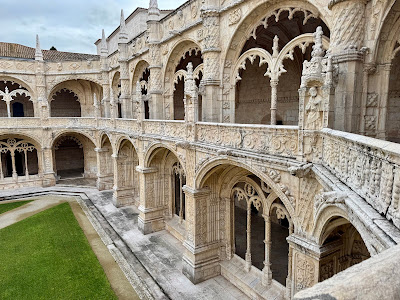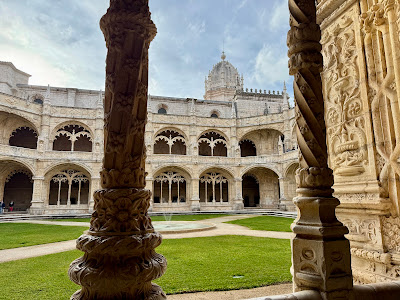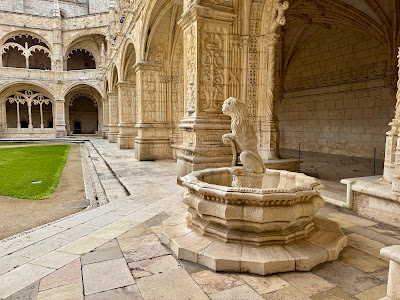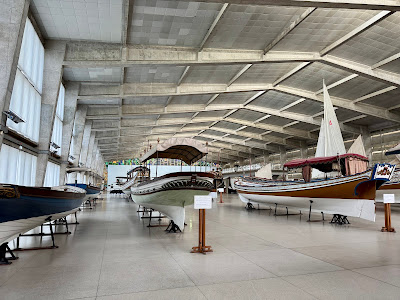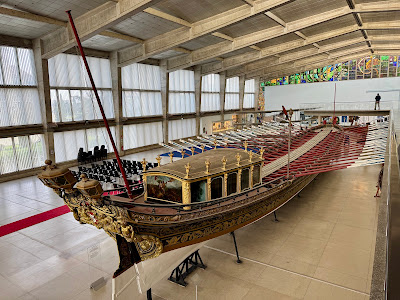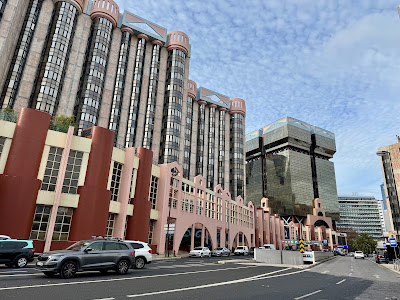Lisbon, Portugal Day 3
The travel to Belém was smooth. The Uber dropped us in front of Pastéis de Belém, the famous pastry shop who claims only their Pastéis de Nata to be the original.
I expected to see a field of Pastéis de Nata at the first step in the shop, but we didn't. Instead their showcase was filled with many kinds of pastries. Where were the famous egg tarts???
I heard that there is always a long queue for the shop as well as the cafe, but nobody waited for either around 8am, right after the shop opened. We were nicely seated in one of the cafe rooms and ordered fresh orange juice, cappuccino for J, black tea with milk for me, ham and cheese croissant sandwich for J, Bolos de Arroz for me, and egg tarts for us!
It is believed that Pastéis de Nata was invented by Catholic monks residing within the Jeronimos Monastery, located just a block away from the pastry shop, prior to the 18th century. After the Liberal Revolution of 1820, the Monastery was shut down as many other convents and monasteries did in 1834. There was a small general store attached to a sugar cane refinery next to the Monastery and someone from the Monastery offered Pastéis de Nata in the store to make a living. The egg tarts became so popular quickly and called as 'Pastéis de Belém.' In 1837 the owners of the sugar cane refinery opened a facility to bake Pastéis de Belém, attached to the refinery. That was the beginning of the pastry shop and cafe. Today they are still hand-baking Pastéis de Nata, following the original recipe from the Monastery in the 'secret room,' and their Pastéis de Nata are only called 'Pastéis de Belém' because of their authenticity. The shop proudly sells over 20,000 tarts daily!
So, was the Pastel de Belém better than or different from those I had eaten? Honestly, it was! The custard cream was clearly more egg-y and flavorful without being so sweet. The buttery flaky crust was holding the custard cream beautifully. This was my fifth egg tarts of this trip and it was the best so far. By the way, Bolos de Arroz is a traditional Portuguese muffin made with part rice flour. The crumb was lovely tender with a hint of lemon and not too sweet. I would like to make my own Bolos de Arroz so that J could taste one.
Of course, we paid a visit to the Jeronimos Monastery, the birth place of Pastéis de Nata. The building of the Monastery was enormous and it looked like a royal palace. The construction of the Monastery began in 1501 under King Manuel's leadership and took more than a century to complete. The structure is an outstanding example of 'Manueline' or Portuguese Late Gothic style architecture.
The self-guided tour started at the upstairs of the two-story cloisters. We were the first visitor of the day!
The stone carved arches and columns were remarkable! It was enjoyable to find exotic creatures and sea motifs on them. The construction of the Monastery was during the Age of Discovery and the profits gained from the gold and other precious stones as well as spices found in India made it possible.
We came down to the ground level. The beautiful decorative corridors continued.
The Chapter House was accessible, which used to be served as a meeting place for the monks. The room was almost empty but the tomb of Alexandre Herculano, a historian, novelist, and poet in 19th century Portugal at the center of the room as well stone carved ornaments on the walls.
The monks would wash their hands at the small fountain with a lion statue before praying or eating in the Refectory. According to legend, Saint Jerome found a lion in the Monastery whose paw was hurt by a thorn. He removed the thorn and treated the wounded paw. Since then, the lion lived with Jerome thankfully.
Behind the fountain was the Refectory, a historic dining area used by the monks. The walls were decorated with the panels of Azulejos, Portuguese (and Spanish) ceramic tiles. The room was pretty large.
We were supposed to visit the Monastery's church after the cloister visit but unfortunately it was temporarily closed on the day. We walked up to the Maritime Museum, situated in the west wing of the Monastery. It was open!
The museum has a fine collection of over 20,000 objects that represent Portugal's maritime history, including model ships, nautical instruments, maps, weapons, etc. Portugal was once the world leader of the sea and has many stories to tell. Surprisingly we saw only a few other visitors while we were in the museum while there were so many people in the cloister. I guess that they don't know the imposing museum is next door.
The Galleys Pavilion of the museum houses a variety of historical vessels. After seeing hundreds of small models, they looked giant!
There were several royal barges, including the Bergantim Real that was built in 1780. The galley with 40 oars was last used was when Queen Elizabeth II of UK officially visited Portugal in 1957. It took the Queen from Her Majesty's Yacht Britannia (we visited the ship some years ago!) to the Cais das Colunas pier (we visited on the first day of this trip!).
Three historical seaplanes were also displayed. We spent a good amount of time at the museum. It was worth visiting!
Then we headed to the bank of Tagus River to see another famous Manuelino style architecture in Belém. Built between 1514 and 1519, the Belém Tower tower was originally built to guard the Monastery and the port of Lisbon and also served as a prison and a customs post. You can enter and see the inside but there was a long queue. We just admired the handsome exterior with the calm water in the background, which is considered the highlight of the tower anyway.
We strolled along the river toward the Monument to the Discoveries. It was a lovely day out!
The monument was originally built in 1940 in a temporary form for the Portuguese World Exhibition and then it was rebuilt in 1960 for the 500 year anniversary of the death of Infante Dom Henrique, fifth son of King John I and D. Filipa of Lancaster, known as Henry the Navigator. He stands at the very front on the monument, followed by 32 important figures from the Age of the Discoveries.
The west side was crowded with visitors while the east side was somehow people-free... Did they know the monument had both sides?
We took an Uber to LX Factory for lunch. Located between Belem and Lisbon's city center, LX Factory is a historical industrial complex that houses more than 50 shops, restaurants, cafes and bars.
We browsed some souvenir shops. J picked up three small bottle of Ginja, Portuguese sour cherry liqueur, from different brands as well as a small bottle of Portuguese bitter almond liqueur.
Many restaurants looked casual, more like street food vendors. We took a break from Portuguese cuisine and tried a Mexican restaurant, Mex Factory, which had good reviews. We ordered Carnitas (slow cooked pork) tacos and a Pollo (chicken) burrito. Well, they were just ok.
Our next destination was the Amoreiras shopping center. It was about an hour walk to be at the flagship mall of Lisbon from LX Factory. We had enough time and the weather was comfortable, so we took a walk. I didn't know the way would be lots of uphills, though...
We passed through the residential area mostly. It was nice to see buildings with Azulejo tile façades sometimes on the way.
Suddenly a shiny modern building complex showed up in front of us. That was the Amoreiras shopping center!
We looked at some shops but didn't find anything we would like to buy after all. I was quite tired at that time and we went back to our hotel to rest.
To be continued...

















